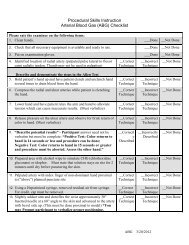View Annual Report 2012 - University of Illinois College of Medicine ...
View Annual Report 2012 - University of Illinois College of Medicine ...
View Annual Report 2012 - University of Illinois College of Medicine ...
Create successful ePaper yourself
Turn your PDF publications into a flip-book with our unique Google optimized e-Paper software.
2 NeWS<br />
LIght-SeNSItIve<br />
MOLeCULe<br />
Signaling retinal cells<br />
to respond to light<br />
UIC vision scientists and chemists<br />
recently created a light-sensitive molecule<br />
that can stimulate cells <strong>of</strong> the retina<br />
— a photochemical on-<strong>of</strong>f switch that<br />
someday may lead to new treatments for<br />
degenerative eye diseases such as agerelated<br />
macular degeneration (AMD).<br />
Diseases such as AMD destroy<br />
photore ceptor cells that sense light and<br />
start the visual process. However, other<br />
retinal cell types, while not normally<br />
photosensitive, <strong>of</strong>ten remain healthy.<br />
“We asked ourselves, ‘Could we make<br />
healthy retinal cells responsive to light<br />
and bypass dead photoreceptor cells?’”<br />
says David Pepperberg, PhD, Searls-<br />
Schenk Pr<strong>of</strong>essor <strong>of</strong> Ophthalmology and<br />
Director <strong>of</strong> the Photoreceptor Research<br />
Laboratory.<br />
Remarkably, the answer seems to be<br />
“yes.” The team’s focus: a neurotransmitter<br />
known as GABA (gamma-aminobutyric<br />
acid) that activates a receptor<br />
protein involved in visual signaling within<br />
the retina. The researchers synthesized<br />
new compounds built upon the anesthetic<br />
prop<strong>of</strong>ol, a small molecule that<br />
binds to and regulates GABA receptors.<br />
The new molecule is known as<br />
MPC088. As light <strong>of</strong> different wavelengths<br />
strikes it, MPC088 changes<br />
shape and functions essentially as a light<br />
switch for the GABA receptor. “It’s the<br />
outcome <strong>of</strong> many attempts,” says Dr.<br />
Pepperberg, Principal Investigator <strong>of</strong><br />
David Pepperberg, PhD<br />
the study, which won funding from the<br />
National Eye Institute.<br />
The UIC chemists led by Karol<br />
Bruzik, PhD, Pr<strong>of</strong>essor, <strong>College</strong> <strong>of</strong><br />
Pharmacy, soon realized they had<br />
produced a molecule with broader<br />
implications. That sparked a collaboration<br />
with scientists at the <strong>University</strong> <strong>of</strong><br />
California, Los Angeles (UCLA), led<br />
by Thomas S. Otis, PhD, Department<br />
<strong>of</strong> Neurobiology, who are exploring<br />
MPC088’s potential to reduce<br />
epileptic seizures.<br />
Turning the light switch <strong>of</strong>f is also<br />
critical. Next for the UIC team is an<br />
attempt to program in “temporal tuning”<br />
and make the molecule revert back<br />
within a certain timeframe — essential<br />
for future clinical applications.<br />
The team also wants to incorporate a<br />
targeting component — a cellular GPS —<br />
to boost MPC088’s affinity for reaching<br />
the appropriate receptor site. “It’s a major<br />
challenge,” says Dr. Pepperberg, “but<br />
we’re excited to be pursuing what we<br />
The findings were published online<br />
in November in the journal Nature<br />
Communications. The paper’s co-first<br />
authors were Lan Yue, PhD, and<br />
Michal Pawlowski, PhD, UIC; and<br />
Shlomo S. Dellal, PhD, UCLA.<br />
In addition to the National Institutes<br />
<strong>of</strong> Health, the study has received key<br />
support from the Daniel F. and Ada L.<br />
Rice Foundation, the Arnold and Mabel<br />
Beckman Initiative for Macular Research,<br />
American Health Assistance Foundation,<br />
Hope for Vision, Research to Prevent<br />
Blindness, and the UIC Center for<br />
Clinical and Translational Science.<br />
believe is a promising approach.” Chemical structures, including light-sensitive MPC088<br />
(top). Reprinted with permission <strong>of</strong> Nature Communications.<br />
OH<br />
OH<br />
O<br />
Prop<strong>of</strong>ol MPC088<br />
O<br />
O<br />
H<br />
N<br />
H<br />
N<br />
N<br />
N<br />
N<br />
N<br />
OH<br />
O<br />
MPC100<br />
O<br />
H<br />
N<br />
N<br />
H<br />
N<br />
H<br />
MPD021<br />
H<br />
N<br />
O<br />
NH 2<br />
N<br />
N<br />
O<br />
24<br />
O<br />
N<br />
H<br />
N<br />
H<br />
O<br />
O<br />
N<br />
NH 2<br />
O


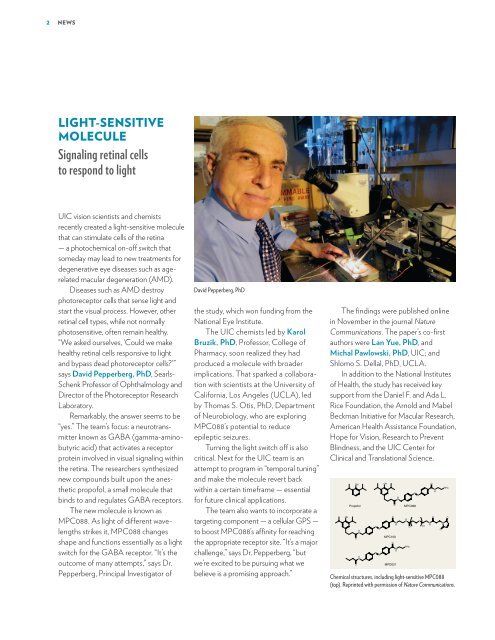

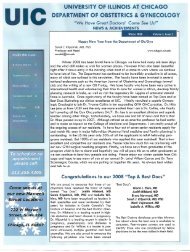
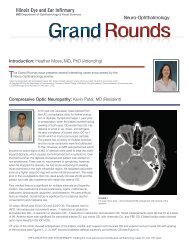
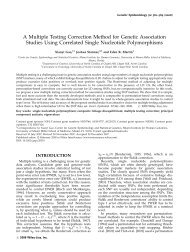

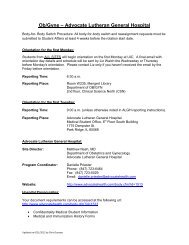

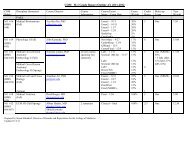

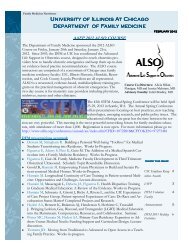

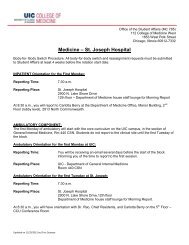
![CV Joan [W51] - University of Illinois College of Medicine at Chicago ...](https://img.yumpu.com/17336863/1/190x245/cv-joan-w51-university-of-illinois-college-of-medicine-at-chicago-.jpg?quality=85)

